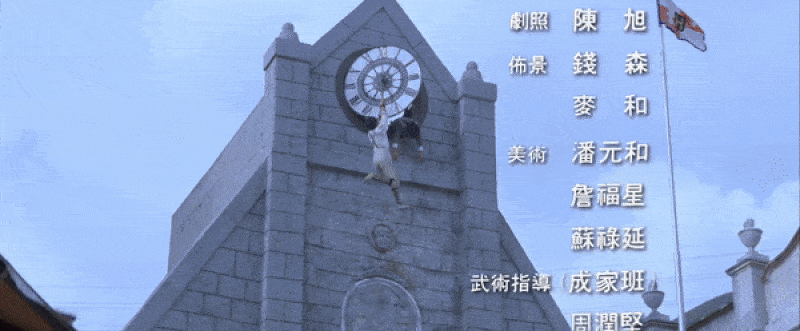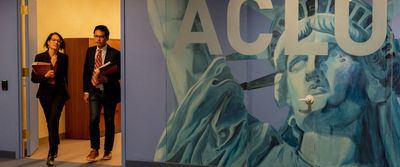How They Shot the Explosive Pole Jump Stunt in ‘Police Story’
Welcome to How’d They Do That? — a bi-monthly column that unpacks moments of movie magic and celebrates the technical wizards who pulled them off. This entry explains how Jackie Chan did the shopping mall pole stunt in Police Story.
Without mincing words: Police Story (1985) is the pinnacle of Jackie Chan‘s career.
After three failed attempts to break into Hollywood, Chan attacked Police Story with a vengeance. His most recent Western foray, The Protector, had outfitted Chan as a serious, gun-wielding Dirty Harry-type. But just as Chan wasn’t Bruce Lee…he also wasn’t Dirty Harry. Those molds weren’t his. And Police Story was his opportunity to clarify what kind of action star he wanted to be.
Chan served as Police Story‘s director, writer, star, and stunt coordinator. He even sang the theme song. If there was ever a film dedicated, with every fiber of its being, to stunts, this was it. Police Story has more action in its first fifteen minutes than most films have in their entire runtime. The script was literally written around a grocery list of set pieces. The production even earned the nickname “Glass Story” because the JC Stunt Team barrelled through seven-hundred pounds (Chan’s estimate) of collapsible sugar glass.
Chan plays a cop named Chan Ka-Kui, a hot-headed goof who finds himself neck-deep in the mob after he’s assigned to protect Salina Fong (Brigitte Lin), a witness for the prosecution. In the film’s conclusion, Selina goes to the office of the mob boss (Chor Yuen), which is located in a shopping mall, to steal incriminating evidence. The mob catches on. And because Ka-Kui is following their movements, all parties involved wind up in an all-out mall brawl.
In the ensuing carnage, the briefcase containing the all-important evidence falls to the bottom of the mall’s atrium, where the mob boss retrieves it. From the top floor, desperate and out of options, Ka-Kui launches himself off the guard rail. He slides down a multi-story vertical pole, electricity arcing around him as he slams through string after string of decorative lights. Ka-Kui plummets through a glass plane into an unassuming kiosk, and without missing a beat, he hops back on his feet and detains his adversary.
The pole jump is the biggest stunt of a film defined by big stunts. It’s breathtaking and unfathomable, and yet there it is, unambiguously on the screen. So how did Jackie Chan do it?
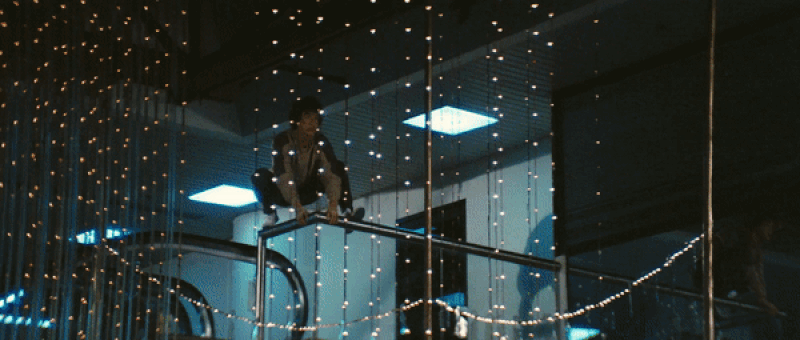
How’d they do that?
Long story short:
Jackie Chan plain old just did it. They shot the Police Story pole stunt in one take with no rehearsals, wires, or crash pads.
Long story long:
If the pole jump in Police Story looks extraordinarily dangerous, that’s because it was.
As relayed in a 2017 interview with IGN, at this point in the shoot, Chan was sick, and it’s easy to understand why. Chan was shooting Heart of Dragon with Sammo Hung during the day and working on Police Story by night. Even in the context of Hong Kong cinema’s frantic production schedule, he wasn’t so much burning the candle at both ends as hucking the candle into a fireplace.
In an undated interview included with the film’s Criterion release, Chan estimates that his crew had already been shooting in the mall for several months. By the time they got to the pole stunt, the Police Story production was under some degree of pressure from the mall to wrap up. By the time the pole stunt was set up, the sun had begun to rise. There was going to be a lot of broken glass to clean up before the mall opened in the morning. While Chan is somewhat infamous for taking the time to get stunts right, in this instance, there was a real sense of urgency.
Chan and his team did not rehearse the stunt. And as if the stakes weren’t high enough, there were no wires, crash mats, or safety nets. If Chan missed the pole there would be nothing to catch him or break his fall.
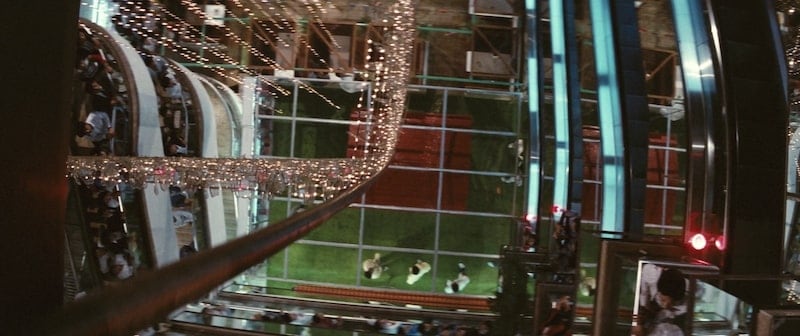
The original plan was to power the lights with a low-voltage car battery. But, as they discovered on the day, the car battery just wasn’t able to power the whole structure. So they plugged the lights into wall sockets. This meant that the voltage of the building itself could potentially electrocute Chan. To assuage Chan’s understandable concern, the tech crew assured him that if anything went wrong they would simply cut the power. If you’ve had the pleasure of being electrocuted, you’ll know that shutting off a power source helps but doesn’t exactly undo the fact that you’ve been shocked. And such a jolt could have loosed Chan’s grip. or worse.
Chan perched on the guard rail six floors above his final destination: a prop kiosk shielded by sugar glass. He told the crew that he would give a signal before initiating the stunt (“when I nod, I’m going”). Chan was, by his own admission, rather scared. A member of the JC Stunt Team snuck a good luck totem into Chan’s pocket during a hug.
As Chan tells it, a crewmember mistook a nervous neck motion for the “go” signal. Someone shouted “rolling!” and the deathly quiet atrium filled with the motors of all twelve high-speed cameras. That amount of camera coverage was exceptional at the time, especially within Chan’s own filmography. But they only had one shot at it. And they only had 400 feet of film. Knowing this, Chan let out a scream and jumped.
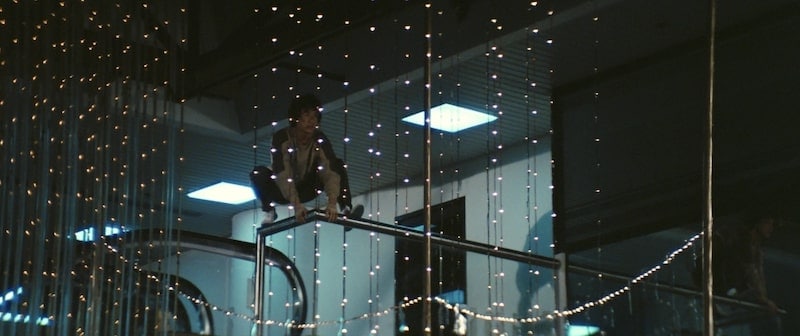
By Chan’s estimate, the distance from the guard rail to the pole was about eight feet, which he cleared without a running start from an unstable crouching position. During the descent, the string lights did not electrocute Chan. But they did have a different, unforeseen effect. Incandescent light bulbs are hot to the touch. They can even ignite paper and certain kinds of cloth with direct contact. So, when you put a thermal conductor like a metal pole under stage lights and in the middle of a constellation of active bulbs…what you’re going to get is a very hot metal pole.
The heat, coupled with the friction of the descent, resulted in second-degree burns on Chan’s palms. For the morbidly curious (don’t worry you’re in good company), a second-degree burn is any burn that penetrates the dermis, which is where your blood vessels and nerves are.
As notable Jackie Chan fan Edgar Wright underlines, the real kicker of the whole affair is that the instant Chan hits the floor, he gets up and starts fighting. This is all the more impressive considering, as Chan relays in his autobiography, the impact of the fall dislocated his pelvis and caused a back injury that could have been paralyzing. As Chan tells it, his adrenaline was so high that the stuntman he wails on had to tell him to stop. They wrapped the shoot and had a celebratory beer (at six in the morning). Chan then made his way to the Heart of the Dragon set where he promptly crashed.
What’s the precedent?
The pole stunt in Police Story is so remarkable it actually breaks the film’s continuity. As it appears on-screen, the pole jump doesn’t play out just once. In quick succession, Chan shows us the stunt three whole times.
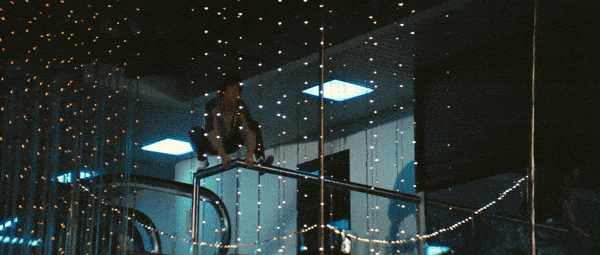
Repeat Cuts are a tool used for visual emphasis. They break the “invisible” flow of editing to maximize a visceral payoff of things like a killing blow, a car crash, or an impressive explosion. It is very difficult to make Repeat Cuts feel diegetic. Though, in all fairness, many never set out to feel diegetic in the first place.
This is, in part, what makes the Repeat Cut in Police Story so interesting. Jackie Chan isn’t just breaking immersion to milk the spectacle of a stunt. He’s making a very bold fourth-wall-breaking point about who he is as an action star. Namely: “Look at how dangerous that was. I did that.”
That isn’t something all performers can claim. And depending on how you feel about on-screen verisimilitude and off-screen safety, that might not even be something you want to claim. But that’s kind of Chan’s point. He is willing to take genuine, life-threatening risks and that’s part of what makes his brand of action special.
On-screen and off, Jackie Chan is compelling because he sweats, takes a beating, and works hard to overcome obstacles. And a part of this appeal (again, on-screen and off) is that you know how hard he works. In part, because he straight up tells you. In case there was any ambiguity, Police Story‘s end credits feature a triumphant montage of Chan directing the film.
Many compare Chan to the likes of Buster Keaton, Harold Lloyd, and Fred Astaire, legends whose main special effect was that they could just plain “do the thing.” Project A (1983), Chan’s directorial effort before Police Story, was a love letter to his old Hollywood heroes. In one stunt, emulating Lloyd’s Safety Last! (1923), Chan dangles off a clocktower, dropping through awning canopies before hitting the ground. In the take featured in the end credits, Chan lands distressingly on his head, folding in half like a lawn chair.
All to say, Chan makes a very unique and calculated point to not make his magic tricks look easy. Instead of grace, there is effort. And instead of invincibility, there is cervical spine damage.
